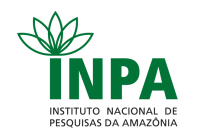Corpo Discente - Egressos
Fernando Luiz Figueirêdo
| Título | BIOECOLOGIA DO ÁCARO-HINDUSTÂNICO-DOS-CITROS (Schizotetranychus hindustanicus) EM LARANJA E DO ÁCARO-BRANCO (Polyphagotarsonemus latus) EM MAMOEIRO EM RORAIMA, BRASIL | ||||||||||||||||||||||||
| Data da Defesa | 28/02/2020 | ||||||||||||||||||||||||
| Download | Visualizar a Tese(1.99MB) | ||||||||||||||||||||||||
Banca
| |||||||||||||||||||||||||
| Palavras-Chaves | praga-quarentenária, manejo integrado de pragas, ácaros predadores, dinâmica populacional. | ||||||||||||||||||||||||
| Resumo | Os citros e o mamão são as principais fruteiras perenes produzidas no Brasil e em Roraima. Dentre as principais pragas que afetam a cultura dos citros em Roraima está o ácaro-hindustânico-dos-citros, Schizotetranychus hindustanicus, e das que atacam o mamão, está o ácaro-branco, Polyphagotarsonemus latus. Apesar das grandes infestações e danos causados por estes ácaros-praga, não existem informações bioecológicas que suportem programas de manejo integrado desses ácaros no estado. Estudos que visem entender a dinâmica populacional de pragas in loco são extremamente importantes para traçar as estratégias de manejo integrado das mesmas, permitindo que o produtor adote medidas nos momentos em que as pragas se encontram menos favorecidas pelas condições ambientais, aumentando assim as chances de controle. Desta forma, este trabalho objetiva contribuir para o conhecimento dos aspectos bioecológicos de ácaros pragas associados a culturas específicas em Roraima, bem como determinar a distribuição geográfica do ácaro-hindustânico-dos-citros, sua dinâmica populacional e a preferência de local de ataque na planta, em um pomar de laranja e a dinâmica população do ácarobranco em um pomar de mamoeiro, em Caracaraí, Roraima, com intuito de bioprospectar inimigos naturais para o controle biológico e propor medidas de manejo destes ácarospraga em Roraima. Para tanto, a tese foi dividida em três capítulos, o primeiro trata da distribuição geográfica de S. hindustanicus e ácaros associados em Roraima, o segundo e o terceiro sobre a dinâmica populacional de S. hindustanicus e de P. latus, respectivamente. Um levantamento para detecção de S. hindustanicus e potenciais inimigos naturais foi realizado nos meses de agosto e setembro de 2015, nos 15 municípios de Roraima. Schizotetranychus hindustanicus foi encontrado em todos os 15 municípios do estado. Os ácaros predadores da família Phytoseiideae: Amblyseius aerialis (Muma), Iphiseiodes zuluagai Denmark & Muma e Euseius concordis (Chant) foram os predadores mais abundantes no levantamento e são potenciais agentes de controle biológico de S. hindustanicus. A dinâmica populacional de S. hindustanicus foi realizada em um pomar de laranja no período de junho de 2016 a dezembro de 2018 no município de Caracaraí, Roraima. As maiores densidades de S. hindustanicus ocorreram nos períodos de menores precipitações pluviométricas. Não houve diferenças entre a densidade de ovos nos diferentes quadrantes, estratos e posição das folhas no ramo na planta e a densidade em toda a planta, portanto a amostragem do ácaro pode ser feita em qualquer posição da planta. Ácaros predadores Amblyseius (Phytoseiidae) foram encontrados durante o estudo. A dinâmica populacional do ácaro-branco foi estudada em um cultivo de mamoeiro, no município de Caracaraí-RR de fevereiro de 2016 a agosto de 2017. Apenas 12 plantas de mamão foram observadas com sintomas do ataque de P. latus e de outras pragas. Isso deve estar relacionado ao fato de o experimento ter sido instalado em uma área recém aberta no meio de uma floresta que deve ter funcionado como uma barreira natural às pragas. O principal predador associado a P. latus é Amblyseius sp. (Acari: Phytoseiidae). Esses resultados podem servir de base para o melhor manejo do ácaro-hindustânico-dos-citros e o ácaro-branco nas culturas da laranja e mamão em Roraima. Estudos com os inimigos naturais observados são necessários para avaliar sua eficiência no controle biológico dessas pragas. | ||||||||||||||||||||||||
| Abstract | The cirus and papaya are the main perennial fruit trees produced in Brazil, especially in the state of Roraima. Among the most important pests affecting the culture of citrus in Roraima, Schizotetranychus hindustanicus is highlighted; among the most important pests affecting the culture of papaya Polyphagotarsonemus latus. Despite the great infestations and damages caused by these mites-pest, there is no bioecological information about these species supporting programs of integrated management of these mites in the state of Roraima. Studies to understand the population dynamics of pests in loco are very important to design strategies of integrated management of them, allowing the producer to take actions when the pests are less favored by environment conditions, increasing the chances of control. Thus, the objective of this work is to determine geographical distribution of Schizotetranychus hindustanicus, its population dynamics and the propensity of site of attack on the plant, in an orchard of orange and the population dynamics of Polyphagotarsonemus latus in an orchard of papaya, in Caracaraí, to prospect natural enemies for biological control and to suggest actions of management of these mites-pest in Roraima. For this, the thesis was divided in three chapters, the first one discusses the geographical distribution of S. hindustanicus and associated mites in Roraima, the second and the third chapters discuss the population dynamics of S. hindustanicus e de P. latus, respectively. A survey for detection of S. hindustanicus and potential natural enemies was accomplished in August and September 2015, in the fifteen cities of Roraima. Schizotetranychus Hindustanicus was found in all the fifteen of the state of Roraima. The predatory mites from the family Phytoseiideae: Amblyseiusaerialis (Muma), Iphiseiodeszuluagai Denmark&Muma e Euseiusconcordis (Chant) were the predators most abundant on the survey and they are the potential agents of biological control of S. hindustanicus. The population dynamics of S. hindustanicus was accomplished in an orchard of orange during the period from June 2016 to December 2018 in the municipality of Caracaraí, Roraima. The biggest densities of S. hindustanicus occured in the periods of smaller rainfalls. There was no difference among the density of egg in the different quadrants, strata and position of leaves on the branch, in the plant and the density in the whole plant. Thus, the sample of mites may be carried out in any position on the plant. Predatory mites Amblyseius (Phytoseiidae) were found during the research. The population dynamics of Polyphagotarsonemus latus was analyzed in a culture of papaya, in the city of Caracaraí-RR from the Februray 2016 to August 2017. Only 12 papaya plants were observed with symptoms of the attack of P. latus and of other pests. It is supposed to be related to the fact the experiment was located in a recently open area in the middle of a woodland which might have worked as a natural barrier against the pests. The main predator associated to P. latus is Amblyseius (Acari: Phytoseiidae). These results may be used as basis for the best management of Schizotetranychus hindustanicus and Polyphagotarsonemus latus in the cultures of orange and papaya in Roraima. Studies with the natural enemies observed are necessary to assess the efficiency on the biological control of these pests. | ||||||||||||||||||||||||
Parceiros

























